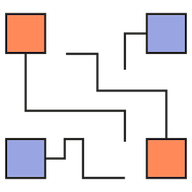|
|
4 years ago | |
|---|---|---|
| assets/img | 4 years ago | |
| diagrams | 4 years ago | |
| docs | 4 years ago | |
| resources | 4 years ago | |
| scripts | 4 years ago | |
| templates | 4 years ago | |
| tests | 4 years ago | |
| website | 4 years ago | |
| .gitignore | 4 years ago | |
| CONTRIBUTING.md | 4 years ago | |
| README.md | 4 years ago | |
| autogen.sh | 4 years ago | |
| config.py | 4 years ago | |
| poetry.lock | 4 years ago | |
| pyproject.toml | 4 years ago | |
README.md

Diagrams
Diagram as Code
Diagrams lets you to draw the cloud system architectures in Python code.
It was born for prototyping a new system architecture without any design tools. You can also describe or visualize the existing system architecture as well.
NOTE: It does not control the actual cloud resources like cloudformation or terraform, but just for drawing the system architecutrre.
Diagram as Code allows you to track the architecture diagram changes on any version control system (same as source code tracking)
Diagrams currently supports three major cloud providers: AWS, Azure, GCP.
Let me know if you are using diagram! I’ll add you in showcase page. (I’m working on it!) :)
Getting Started
It uses Graphviz to render the diagram, so you need to install Graphviz to use diagrams. After installing graphviz (or already have it), install the diagrams.
$ pip install diagrams
You can start with quick start. And you can find guides for more details.
Examples
ContributingF
To contribute to diagram, check out CONTRIBUTING.
